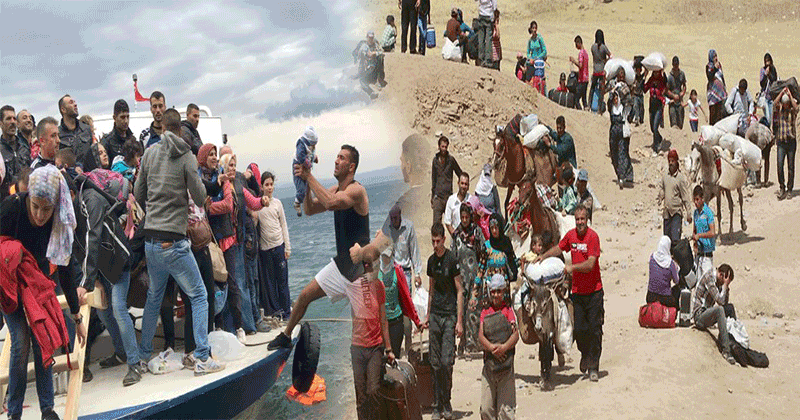
While the world is celebrating TODAY as the International Yoga Day, some 0of us might have forgotten that the 20th of June was World Refugee Day.
After seven decades since India became an independent nation, India has largely welcomed refugees who seek political asylum after fleeing from conflict-stricken nations. As soon as we hear the word ‘refugee’, the words that come to our mind are mass-exodus, human rights violation, irregular migrants and national security at stake.
A ‘refugee’ is a person who is fleeing persecution and conflict. Such victims have been granted asylum in foreign lands for thousands of years. According to the United Nations, the world is witnessing the highest levels of displacement on record. An unprecedented 65.6 million people around the world have been forced from home by conflict and persecution at the end of 2016. Among them are nearly 22.5 million refugees, over half of whom are under the age of 18. There are also 10 million stateless people, who have been denied a nationality and access to basic rights such as education, healthcare, employment and freedom of movement.
Crisis for refugees in India started right during the partition. But, India never failed to welcome refugees on its territory. Millions and millions of people have fled conflict-stricken areas and found asylum in the Indian states.
Refugees of Partition
In 1947, when a country for Indian Muslims was carved out, a massive displacement happened. Hindus living in Pakistan fled to India and Muslims living in India moved to Pakistan. Refugee camps were set up across north India for people who had borne the brunt of partition. It is said the refugee movement during India- Pakistan partition was the greatest migration of modern history. More than 20 million refugees took asylum in India. A lot of them found refuge in the capital city.
Tibetan Refugees
The next major movement of refugees happened a decade later, in 1959. When Dalai Lama, along with more than 1,00,000 followers, fled Tibet and came to India seeking political asylum. For granting asylum to them, India paid a heavy cost by earning the ire of the Chinese government.
Bangladeshi Refugees
Another major refugee movement happened in 1971, during Bangladesh’s war of independence. This led to a sudden spike in population in states bordering Bangladesh, and it became increasingly difficult for the government of India to ensure food security. More than 10 million Bangladeshis flew from their country and took shelter in Indian territory.
Sri Lankan Tamil Refugees
Events like Black July Riots of 1983 and Sri Lankan Civil War forced a sizeable group of Sri Lankan refugees to take asylum in India. Mostly these refugees, who number over a million, settled in the state of Tamil Nadu-nearest to Sri Lanka. India’s involvement in providing asylum to Sri Lankan refugees resulted in the assassination of the then Prime Minister Rajiv Gandhi.
Rohingya Refugees
The world’s fastest-growing refugee crisis, where millions of people are displacing every hour is the Rohingya Refugee Crisis. The United Nations described the exodus, as a “textbook example of ethnic cleansing”. More than 40,000 Rohingya refugees have taken place in India. The United Nations High Commissioner for Refugees has given refugee cards to 16,700 refugees living in India. However, India considers Rohingya refugees as illegal migrants and a security threat siding with the Burmese government.
READ ALSO: Two lakh Rohingya refugees in Bangladesh is at risk from flooding
LESSER KNOWN FACTS ON WORLD REFUGEE DAY
United Nations General Assembly declared June 20 to be celebrated as World Refugee Day on Dec 4, 2000.
World Refugee Day honours the strength and courage of refugees and encourages public awareness regarding refugees who have fled their homeland due to a conflict or natural disaster.
The theme for World Refugee Day 2018 is “Now more than ever, we need to stand #WithRefugees”.
The event is marked in over 100 countries, with the United Nations Refugee Agency, government officials, celebrities, non-profit organizations taking part in organizing events to mark the day.
There are around 65 million people around the world who have been forcibly displaced — that is around one in every 100 people around the planet.
In 2017, violence described as ethnic cleansing in Myanmar drove 6,93,000 Rohingya refugees across the border into Bangladesh.
The civil war in Syria has led to one of the worst humanitarian crisis of our lifetime.
The world’s largest refugee camp is situated in Dadaab, Kenya, which is home to more than 3,29,000 people.
The first ever refugee team competed at the 2016 Olympics in Rio. The team comprised of athletes from countries such as Ethiopia, South Sudan, Syria and The Democratic Republic of Congo.
Nearly half of the world’s 22 million refugees are under the age of 18. This is the highest number of child refugees since World War II.
Altogether, more than half of all refugees worldwide came from three countries- Syrian Arab Republic, Afghanistan, South Sudan.
Developing countries house 84 per cent of the world refugees.
In 2016, Turkey hosted the largest number of refugees for three years in a row — a total number of 2.9 million people. It was followed by Pakistan, Lebanon, the Islamic Republic of Iran, Uganda and Ethiopia.
The United Nations High Commissioner for Refugees has started the #WithRefugees petition to send a message of action, solidarity, and responsibility on behalf of refugees to governments worldwide.

Post Your Comments